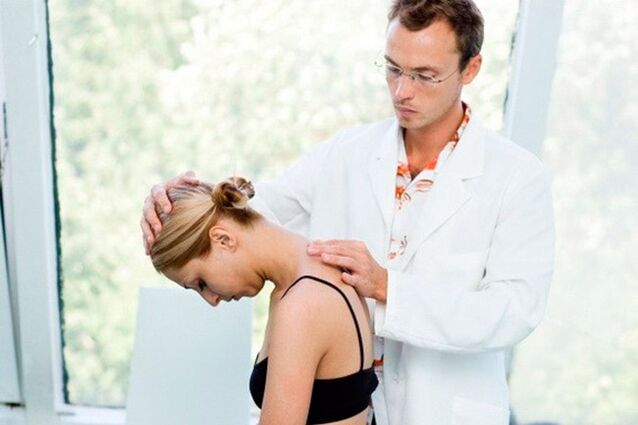Cervical osteochondrosis is a pathology accompanied by degenerative changes of the cartilaginous tissue and intervertebral discs.

Pathology appears as a result of intense stress, inadequate lifestyle and a number of other factors.It was recorded that osteochondrosis develops at 30-40 years old, but every year the disease becomes younger.Today the disease also manifests itself in adolescence.
Causes of cervical chondrosis
As chondrosis develops, the tissues of the vertebrae are affected, causing intense pain and discomfort during movement.Most often, pathology occurs due to excessive load on the problem area.But often chondrosis is formed due to an unstable emotional state and frequent stress.
What reasons provoke the development of the disease:
- Inactive lifestyle.
- Stay in the same poses for a long time.
- Wrong mattress.
- Intense sporting activities.
- Physical work.
- Injury to the problem area.
- Flat feet.
- Age-related changes in the body.
- Bad posture, scoliosis.
- Impaired metabolism, which interferes with the normal absorption of beneficial elements in the body.
- Wear inappropriate shoes.
- Vitamin deficiency in the body.
- Poor nutrition, dehydration.
Bad habits also influence the formation of cervical chondrosis and its unpleasant symptoms.
Symptoms of cervical osteochondrosis
The main symptom that appears first when the pathology develops is pain in the neck, back and shoulders.The patient feels heaviness in problem areas, throbbing, numbness and goosebumps.The pain can change character and go from sharp to painful.The presence of additional symptoms depends on the stage of chondrosis.
As the disease progresses, the patient feels a sensation of fatigue and muscle tension in the neck and shoulders.Discomfort appears not only in the affected area, the pain radiates to the chest, lower back and arm.The pain syndrome impairs the mobility of the upper extremities, makes it difficult to breathe fully, and the patient often feels shortness of breath.
In addition to discomfort, a person's blood circulation is impaired, the functioning of blood vessels deteriorates, which leads to the appearance of swelling and redness on the skin.
What symptoms are accompanied by osteochondrosis of the cervical spine:
- Pain in the neck, shoulders, back.
- Discomfort when moving or doing sports.Feeling of muscle stiffness in the morning, heaviness in the problem area.
- Sensations of tingling and numbness in the problem area.
- Muscle tension, cramps and spasms.
- Aching, pressing headaches that do not go away after taking painkillers.
- Nausea, darkening of the eyes, drowsiness.
- Chest pain.It might feel like a pain in the heart.
- Impaired mobility of the upper limbs.
With cervical chondrosis, the pain often radiates to the area of the shoulder blades and shoulders.As it progresses, the patient experiences headaches and vision problems.Such symptoms indicate that the disease has reached a more serious stage.
How dangerous is the disease?

Cervical osteochondrosis is a serious disease that can lead to regular loss of consciousness, hypertension and vegetative-vascular dystonia.Furthermore, the pathology increases the risk of heart attacks and strokes.Cervical chondrosis can lead to diseases of the kidneys, liver and gastrointestinal tract.
The disease also has a major impact on reproductive function.Osteochondrosis can lead to infertility and impotence.As the pathology develops, a person experiences apathy, regular pain, reduced performance and interest in life.This leads directly to the formation of depression.
Treatment of chondrosis of the cervical spine
For the treatment of osteochondrosis, drugs, traditional methods and physiotherapeutic procedures are used.The specific treatment method is prescribed by the doctor based on the degree of development of the disease.
Pharmacological treatment
Drugs are prescribed in the later stages of the disease, when the patient feels unbearable pain and discomfort during movement.
Treatment of pathology with drugs is aimed at removing the inflammatory process and relieving pain.Drug therapy is prescribed in the form of injections and means for internal use.
What are the functions of drugs:
- Relieves pain and muscle tension.
- I block the inflammatory process.
- Normalizes blood circulation and vascular function.
- Promotes the restoration of cartilaginous tissue.
- Restore mobility.
- Relieves moral stress
For treatment, non-steroidal drugs that relieve pain, anti-inflammatory ointments that help relieve swelling are used.Additionally, intravenous injections are used.
Muscle relaxants are prescribed to dilate blood vessels and relieve muscle tension.Calming products help overcome apathy, drowsiness and distrust.For this purpose, antidepressants and sleeping pills are used.
Traditional medicine
Traditional methods help eliminate the symptoms of chondrosis in the initial stages.Herbal teas are used to eliminate swelling and pain.They not only remove physical discomfort, but also moral stress.
Similar drinks are used internally;The dried leaves of the following plants are suitable for preparation:
- Chamomile.
- Raspberry.
- Mint.
- Dog rose.
Herbal teas have a positive effect on the functioning of the stomach and do not cause side effects.You can drink up to 3 glasses of decoctions per day.Before use, they must be left for several hours.
Therapeutic infusions help to normalize blood circulation, restore mobility and remove numbness in the skin.Pine buds have a beneficial effect on the body.
How to make medicine:
- Add 1 cup of washed buds to the same amount of sugar and mix.
- Pour the resulting mixture with a glass of water and leave it to infuse for 2 weeks.
Take one tablespoon of solution daily during or after meals.Herbal decoctions restore mobility of limbs and relieve moral stress.
How to make the product:
- Pour a small amount of dried dandelion roots into a glass of water.
- Heat the resulting solution in a water bath and leave to infuse in a dark place for 1 hour.
- Filter the broth and take half a glass a day.
It is worth noting that it is not recommended to store herbal infusions for more than 4 days.After this period they lose their beneficial properties and cause adverse reactions.
Physiotherapy, massage, physical therapy
Therapeutic exercises and massage are effective ways to eliminate swelling, pain and discomfort in the neck.All exercises and activities should be performed under the supervision of a doctor, the patient should follow all recommendations to prevent complications.
Gymnastics is performed 3 hours after the meal;It is not recommended to exercise before going to bed.The exact set of exercises is selected by the doctor based on the diagnosis.
Magnetic therapy, acupuncture and electrophoresis help restore flexibility of the spine and eliminate pain.Such methods are prescribed by a doctor if necessary.
Prevention measures
To prevent the development of osteochondrosis, you must adhere to the following rules:
- Maintain a daily routine and get enough sleep.
- Distribute physical activity wisely: do not overwork, but do not lead an inactive lifestyle.
- Choose suitable and comfortable shoes.For flat feet, use special models.
- Sleep on an orthopedic mattress.
- Eat well, avoid unhealthy foods.
- Get rid of harmful addictions.
- Perform simple physical exercises to work all muscle groups every day.
- If discomfort occurs in the shoulders and neck, do self-massage and rub the skin with special ointments.
- If you suspect osteochondrosis, immediately consult a doctor and undergo a comprehensive diagnosis of the body.
To prevent pathology, it is also necessary to restore the emotional state and get rid of life stress.
Osteochondrosis is a serious disease that leads to irreversible consequences.With a vigilant attitude towards your health and timely diagnosis, you will be able to avoid unpleasant complications and return the body to a normal state.

























